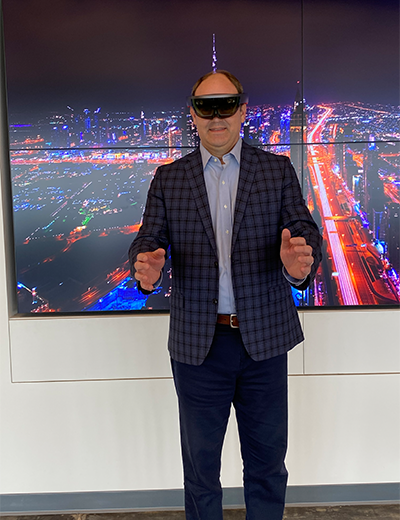BY SCOTT O. JONES, PE
How nice would it be to be able to predict the future?You could always pick the best investments and the winning sports team and retire early.
Though we might not be able to predict the future, we know technology will be a big part of it—something we talk about a lot at BOMA. Sometimes, I think about how far we’ve come in just the past decade. In 2010, fewer than one in three American adults even owned a smartphone! Today, many of us take that technology completely for granted. On a daily basis, I
rely on my phone to enhance nearly every part of my day.
What technology will we be taking for granted 10 years from now? One guess is augmented reality (AR) or virtual reality (VR). My company, Jacobs, has been looking into the applications of VR and AR technology like the Oculus Rift and the Microsoft HoloLens.
As an example: A few months ago, when Jacobs was building out a new office space, we inserted a digital “city rendering” of San Francisco into a project model to show exactly what the views would be from any office window to help employees visualize the end product. I get really jazzed thinking about the possible applications for commercial real estate. We can show tenants exactly what a space will look like once their buildout is complete, which is a powerful marketing tool and a great way to make sure everyone is on the same page from the very beginning. Imagine the difference between looking at a stack of plans and technical drawings and being fully immersed within a virtual representation of the space.
With AR, you’re still seeing what’s around you—just a version of it that has been enhanced with images or information. And, of course, it makes you look very cool (as you can see when I tried out an AR headset, below).
If you’re interested in checking the operations of your building systems, an augmented reality headset could overlay key information onto whatever you’re seeing. You could see how old a filter is and when it needs to be replaced. An automatic warning could pop-up over a high-voltage component to enhance worker safety. You could tell at a glance how efficiently things are operating and if any systems need repair or maintenance.
And, of course, there is so much potential to just make our lives more fun. Something we are trying at Jacobs as a test case is adding fun virtual graphics to everyone’s name and position on their cubicle to show their hobbies. Since I love fishing, when you see my space, you see a virtual fishing pole against the side of my desk. That adds so much magic to a workplace.
We hear about how technology is making us more isolated, but it also has the ability to enhance our lives and our connections with each other. It’s helping us work more efficiently, more safely and more creatively. BOMA is a great partner in connecting members to these emerging trends and evolving tools. I’ve already seen BOMA members trying out virtual and augmented reality headsets on the BOMA International Expo floor. Who knows, maybe one day you’ll be reading BOMA Magazine through one. Personally, I can’t wait to see what the next 10 years bring.

This article was originally published in the March/April 2020 issue of BOMA Magazine.